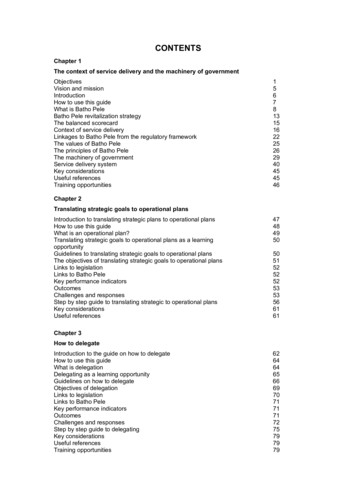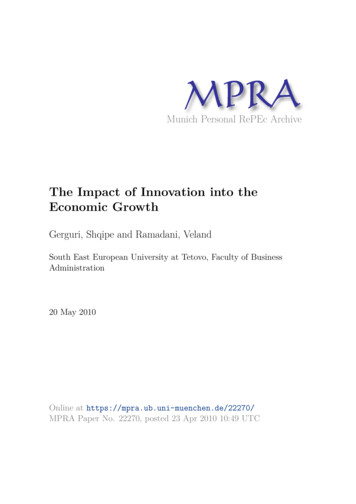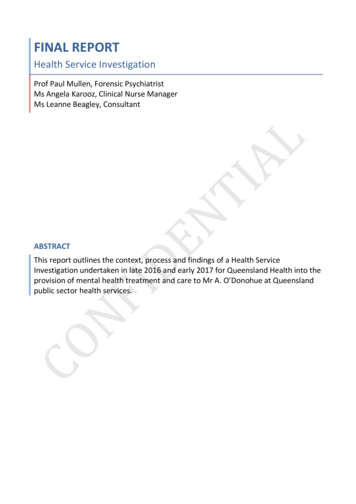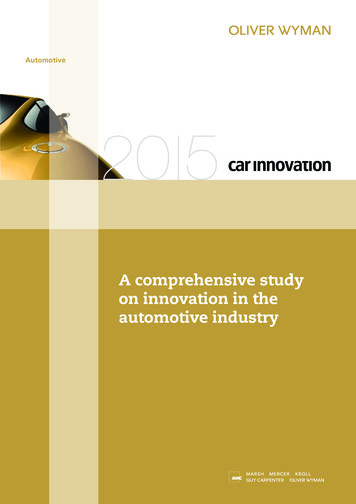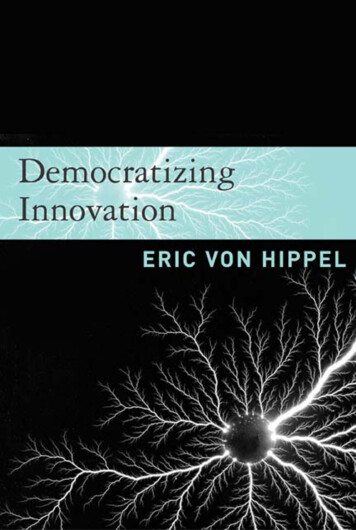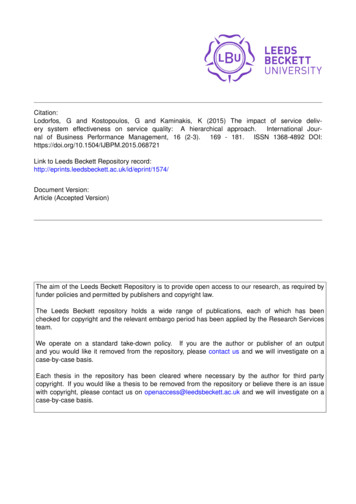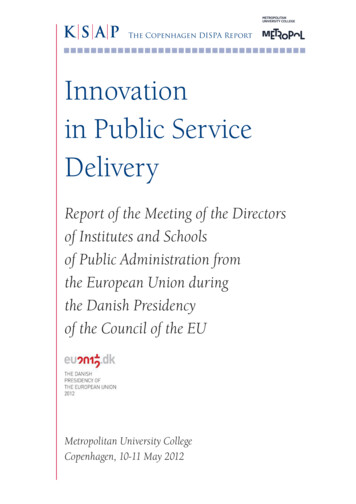
Transcription
The Copenhagen DISPA ReportInnovationin Public ServiceDeliveryReport of the Meeting of the Directorsof Institutes and Schoolsof Public Administration fromthe European Union duringthe Danish Presidencyof the Council of the EUMetropolitan University CollegeCopenhagen, 10-11 May 2012
2K S A PThe Copenhagen DISPA ReportCONTEXT4THE DISPA MEETING6INTRODUCTORY SESSION7Innovation in Public Service Delivery – Consequences for Training (Dr. Nikolaj Lubanski, Prorector, Metropolitan University College, Denmark and Tue Sanderhage, Director, Institute of Management andPublic Administration, Metropolitan University College, Denmark)Opening Speech: Innovation in the Danish Public Sector (Niels Gotfredsen, Director, The Agency for theModernisation of Public Administration, Danish Ministry of Finance)Future Needs – A Student Perspective on Innovation (Emiel Luck, Suzan Burcu, Stephan Thrane – PublicAdministration students, Metropolitan University College, Denmark)PRESENTATIONS AND DEBATE ON INNOVATION9Keynote Speech: Innovation Models (Christian Bason, Head of Innovation, MindLab, Denmark)Collaborative Innovation in the Public Sector (Prof. Dr. Jacob Torfing, Co-director of Collaborative Innovation in the Public Sector, Department of Social Science, Roskilde University)PARALLEL OPEN SESSIONS:CASES FROM THE DANISH PUBLIC SECTOR11What Are the Main Challenges? (Annette Wandel, Chief Consultant, Danish Patients, Denmark; JacobVestergaard, Organizational Anthropologist; Emiel Luck, Suzan Burcu, Stephan Thrane - Public Administration students, Metropolitan University College, Denmark)WORKSHOPS: CASES FROM OTHER EUROPEAN COUNTRIES13Trans-European Case: A European View on Innovation Initiatives Based on the EPSA Studies (Prof. Dr.Marga Pröhl, Director General, European Institute of Public Administration)Dutch Case: Reduction of Administrative Burdens and Simplifying Procedures for Citizens (Saskia Groenewegen, Director, Dutch Institute for Public Administration, The Netherlands)Portuguese Case: Innovation from Within (Mafalda Lopes dos Santos, Director General, National Institutefor Public Administration, Portugal)PLENARY DISCUSSION AND CONCLUDING STATEMENTS16The Background to Innovation – Competence Needs and Consequences for Training (Ole Kjær, Director,Tax and Customs Administration, Danish Ministry of Taxation)A European Perspective on the Road from Challenge to Innovation via Training – What Does It Take? 10Statements on Innovation (Tue Sanderhage, Director, Institute of Management and Public Administration, Metropolitan University College, Denmark)Cyprus, Next Presidency (Dr. Sotos Shiakides, Director General, Cyprus Academy of Public Administration and Marios Michaelides, Senior Training Officer, Cyprus Academy of Public Administration)
3K S A PThe Copenhagen DISPA ReportDISPA INTERNAL ISSUES18On the Survival of the Institutes of Public Administration – the Danish Case (Dr. Nikolaj Lubanski Prorector, Metropolitan University College, Denmark)The Budapest-Warsaw Resolution & the DISPA Wiki (David Walker, Director, European School of Administration)Introducing the IASIA Annual Conference 2012 in Bangkok (Bernard Boucault, Director, Ecole Nationaled’Administration, France)Report on the Joint Conference on Ethics and Deontology in Public Administration, Athens, December 2011(Bernard Boucault, Director, Ecole Nationale d’Administration, France; Fabrice Larat, Deputy Directorof the Department of Education and Training, Ecole Nationale d’Administration, France; Nicolas Georgarakis, Secretary General, National Centre for Public Administration and Local Government, Greece)Conclusion and Announcements of Future Conferences, Workshops and Projects of DISPA MembersANNEXES1. Programme2. List of Participants3. Warm Hands in a Cold Economic Climate (Nikolaj Lubanski, Tue Sanderhage)4. The Public Sector Is Not a Brown Suit (Emiel Luck, Stephan Thrane and Suzan Burcu)5. The Network of Directors of EU Institutes and School of Public Administration (DISPA)6. The Budapest-Warsaw Resolution23
4K S A PThe Copenhagen DISPA ReportCONTEXTTHE DANISH PRESIDENCY OF THE COUNCIL OF THE EUBetween 1 January 2012 and 30 June 2012, Denmark held the rotating Presidency of the Council ofthe European Union (EU).The four fundamental priorities for the Danish Presidency were: a responsible Europe a dynamic Europe a green Europe a safe EuropeIn accordance with tradition, the DISPA meeting was organised by the School of Public Administrationlocated in the Presidency country, in this case the Metropolitan University College.METROPOLITAN UNIVERSITY COLLEGE IN BRIEFThe Metropolitan University College (Metropol) is both an educational institution and an active andvibrant knowledge institution – one that is involved in social development, poses questions and provides answers. It trains the individuals who bind society together and generate growth and prosperity.Three of the College’s core activities come together in two faculties: The Faculty of Social Sciences and Education: study programmes, postgraduate studies andresearch and development into management, leadership and social work. The Faculty of Health Professionals and Technology: study programmes, postgraduate studiesand research and development into health, schools, nutrition, nature and technology.The interrelationships between research, teaching and the professional world serve as the sourceof the knowledge that Metropol generates – and of its long-term effects. Metropolitan graduates aretrained to join important professions, and to be innovators within them. It is not enough that theymaster their own professions and disciplines. They must also contribute to renewal and development.Metropolitan strives to be an academic spearhead, with study programmes based on close interrelationships with practice, and supported by relevant research and development. Digital means of pursuingthese objectives are of increasing importance. Digital solutions help improve dialogue with the restof society and meet the students and partners in the real world. Metropolitan’s guiding principle is“knowledge that works, knowledge that challenges”.THE NETWORK OF DIRECTORS OF EU INSTITUTES ANDSCHOOLS OF PUBLIC ADMINISTRATION (DISPA)Although the members of DISPA are diverse in terms of their role, status, mission and financing, theircooperation has been considerable over the years. As a result of the exchanges of experience and bestpractice that form the basis of DISPA meetings, its members have i.a. been able to embark upon variousjoint activities on an ad hoc basis, or even more permanently, have commissioned studies, developedcommon training programmes, offered traineeships, and so on. Since 1997, the member state holdingthe rotating Presidency of the EU has usually organized a DISPA meeting.
5K S A PThe Copenhagen DISPA ReportPRE-MEETING DISPA TRIO CONSULTATIONSSince the German Presidency of 2007, DISPA meetings have generally been prepared by a “troïka”composed of the schools in the countries of the past, present and two subsequent Presidencies. TheEuropean School of Administration is also associated, notably to contribute to the coordination ofthe Network’s activities and to ensure a degree of continuity from one DISPA meeting to the next.The preparations for the Copenhagen DISPA meeting included a troïka meeting, which took placeon 10 February 2012 at Metropol and discussed the themes and organisation of the meeting itself. Itwas chaired by Dr. Nikolaj Lubanski, Prorector of Metropol and also attended by Mr. David Walker,Director of the Brussels-based European School of Administration (EUSA), Ms. Karine Auriol, Trainingand Development Adviser, EUSA, Prof. Jacek Czaputowicz, Director of Poland’s National School ofPublic Administration (KSAP), Dr. Roxana Zyman, Analyst, KSAP, Dr. Sotos Shiakides, Director General,Cyprus Academy of Public Administration, Mr. Tue Sanderhage, Head of Metropol’s Department ofManagement and Administration, and Ms. Lisa Brønnum, Senior Advisor, Research & Development,Metropolitan University College, Denmark.During the meeting, participants received the Warsaw DISPA Report on “Leadership in a ChangingPublic Administration”, which was welcomed and regarded as an excellent record of proceedings andthe decisions taken. The representatives of Poland’s National School of Public Administration (KSAP)were asked to help with the writing of the Copenhagen DISPA Report.
6K S A PThe Copenhagen DISPA ReportTHE DISPA MEETINGThe Copenhagen DISPA meeting took place on the premises of Metropol on 10-11 May 2012 aroundthe theme of “Innovation in Public Service Delivery” and the consequences for training civil servants.A copy of the programme is contained in Annex 1.The main purpose of the meeting was to reach a communiqué with 10 statements: 5 general learning points on how to enable innovation in public service delivery; 5 recommendations concerning consequences for training.In addition to the national schools in EU countries there were representatives of the European Schoolof Administration (EUSA), Brussels; the European Institute of Public Administration (EIPA), Maastricht and the Regional School of Public Administration (ReSPA), Danilovgrad, Montenegro as well asrepresentatives from the Schools in Croatia, Iceland, Norway, Switzerland and Ukraine. A completelist of participants is contained in Annex 2.Some students and teachers from Metropol also attended and delivered presentations.The meeting was chaired by Dr. Nikolaj Lubanski, Prorector of Metropolitan University College(Metropol) and Mr. Tue Sanderhage, Head of Metropol’s Department of Management and Administration.OUTCOMES OF THE MEETINGThe meeting benefited from a wealth of contributions by DISPA members and guest speakers alike.It was a successful event, as it led to learning points on several matters relevant for the participants.Specifically, the main outcomes of the meeting were as follows: An opportunity to discuss public administration challenges and the need to create smart solutionsfor those that are common to European countries: a) the need to scale down citizens’ expectations of government and public services and the numbers of people those services will benefit;b) the dilemma between wanting to achieve stable and consolidated management of the publicbudget and gaining re-election by demonstrating decisiveness and prompt responses, often basedon individual cases; c) the general crisis of confidence among politicians, administrators, professionals and citizens; A rich exchange of experiences on innovation in public-sector delivery from a general debate oncurrent and future needs to innovating in times of austerity, collaborative innovation in the publicsector, and the road from challenge to innovation via training. The meeting included presentations and discussions on specific cases of innovation in Denmark, and other European countriessuch as The Netherlands and Portugal, as well as a trans-European perspective, culminating inthe consideration of general learning points and consequences for training. The summaries ofspeakers’ presentations are included in the next section. A discussion about some of the current challenges faced by public administration training institutions that are common to DISPA members, not least in regard to concrete cases where thesechallenges have been overcome and a crisis survived (as with Metropol). Institutes and Schools ofPublic Administration may have to face situations such as: structural reform including a merger oforganizations; marketisation of public institutions; increased difficulties to receive basic funding;or difficulties in keeping up the necessary research and development. The strategic choices thatInstitutes and Schools of Public Administration may be able to make could be based, as was thecase for Metropol, on one of three strategies: a) a fight for the status quo; b) re-integration withinthe state administration; or c) a merger with other educational institutions and/or becoming partof the formal educational system in consequence. An opportunity to learn about recent conferences and upcoming workshops, conferences, andother relevant activities of certain DISPA members, as well as an exploration of the possibilities
7K S A PThe Copenhagen DISPA Reportfor future cooperation not least around collaborative research and other joint activities, includingEU projects and the delivery of training. A communiqué with 10 statements: 5 general learning points on how to enable innovation inpublic service delivery and 5 recommendations concerning consequences for training. Consideration of other DISPA matters as a follow-up to the adoption by DISPA members of theBudapest-Warsaw Resolution (Annex 6), such as news concerning the DISPA wiki - recently relaunched by the European School of Administration, a key member of DISPA that aims to support the network as appropriate and to reinforce communication with a view to promoting moreeffective exchange of good practice in relevant fields.INTRODUCTORY SESSIONProrector Dr. Nikolaj Lubanski and TueSanderhage, Head of the Institute of Management and Administration, MetropolitanUniversity College - Innovation in Public Service Delivery – Consequences for TrainingThe meeting was opened by Dr. Lubanski, whowelcomed participants and said that the themeof innovation in public sector delivery hadbeen chosen because of its importance andtimeliness as well as its link with the EUPANwork programme (“an open, adaptable andperforming public administration”). He added however that the particular concern of participantswould be to subsequently focus on the implications of innovation in terms of training and developmentneeds. He also stressed further considerations, including the fact that doing more with less demandeda new mindset and new forms of cooperating and organizing; that DISPA members should try todetermine how training institutes could prepare civil servants for taking the lead in these processesof change; and that the Danish case (with the challenge and the activities at Metropolitan UniversityCollege) is quite relevant for this theme.Dr. Lubanski explained that the challenges faced by the European countries are similar, even if theirwelfare systems are very different. He mentioned three common characteristics: scaled-down expectations; politicians caught between a stable budget and re-election; and a crisis of confidence. In hisintroductory speech, he referred to these common challenges, which were explained in greater detailin an article which he co-authored together with Tue Sanderhage, entitled “Warm hands in a ColdEconomic Climate” (Annex 3), published in the Danish Newspaper Politiken on the day of the DISPAmeeting:1. All European countries need to scale down their citizens’ expectations of government and publicservices.2. Politicians throughout Europe are caught in a dilemma between wanting to achieve stable andconsolidated management of the public budget and gaining re-election by demonstrating decisiveness and prompt responses, often based on individual cases.3. There is a general crisis of confidence among politicians, administrators, professionals andcitizens. The welfare system works best if politicians have confidence that people only ask forbenefits if they need them, and conversely if citizens trust that politicians want what is best forthe public. At the same time, there must be confidence in the professionals’ ability to make aninformed judgment, as well as a confidence in administrators’ ability to create a link betweenpolitical decisions, professional assessments and the public’s expectations regarding fairnessand consideration of the individual.These three challenges are “a tough combination to manage”. The question “how can European countries make massive savings on public spending and encourage people to scale down their expectations,
8K S A PThe Copenhagen DISPA Reportwhile still maintaining confidence in the system?” points out to the necessity of innovation - creating“smart solutions” for “wicked problems”.Mr. Tue Sanderhage, Head of the Institute of Management and Administration at Metropolitan University College, presented the programme for the meeting.Niels Gotfredsen, Director, Agency for the Modernisation ofPublic Administration, Danish Ministry of Finance - OpeningSpeech: Innovation in the Danish Public SectorAfter briefly explaining the mission of his newly created organization – which is to ensure innovation and efficiency inthe public sector – Mr. Gotfredsen continued by talking aboutthe meaning of “innovation”, which “depends on the context”.While innovation and modernization are viewed by many asrelated to digitalisation, the measurement of output and outcome, and obtaining flexible frameworks for management, the speaker emphasised the particularimportance – for public administration – of a strengthened focus on leadership instead of management.Mr. Gotfredsen highlighted the fact that the point of departure for any kind of innovation must bethe specific situation an organisation is in at a given point in time, rather than the situation of others.So care must be taken in using other organisations or companies for benchmarking purposes. Thespeaker also noted that modernisation in a private company is not the same as modernisation in apublic agency, notably because public administrations in the EU are subject to various laws, constitutions and other regulations that set the framework for their activity. The prioritisation of tasks andlevel of activity has to be in compliance with current political decisions.Mr. Gotfredsen also drew attention to the fact that as the activities and expenditure of public administrations always involve the use of taxpayers’ money, there is a particular responsibility for the waytasks are performed and duties discharged.He stated that innovation denoted not merely thinking ‘outside the box’, but also the sweeping andsearching of all corners of the existing box. While referring to the huge potential for minimisingexpenditure in public administration, he offered an example of “innovation in practice” whereby theMinistries in Denmark are currently reporting on their expenditure for the first three months of the yearto the Ministry of Finance and their estimated future spending. This enables the Ministry of Finance todetect more easily whether there are likely to be unused resources that could be transferred to otherareas). In addition, they have introduced a centralised and coordinated system for purchases (e.g. ofIT-equipment, office furniture, etc.), as a means of keeping public spending at the lowest possible level.Mr. Gotfredsen emphasised how, in the light of the fiscal challenges deriving from the economiccrisis, it has become necessary to challenge existing rules and agreements, and to look with an openmind at other options and ways of doing things. A prerequisite if there is to be innovation is thatall stakeholders be open to new ideas and to an exchange of experience across sectors and existinghierarchies, personnel groups, etc.He applauded the idea of inviting students of Metropol – as future employees of the public administration - to contribute to the meeting with their perspectives on innovation, of which careful noteneeded to be taken.Towards the end of his presentation, Mr. Gotfredsen addressed a special message to DISPA members ashe stressed that education and training had to be targeted at tackling the current and future challengesthat public administration faces. By doing this, through both innovative as well as more traditionalmeans, much could be done to ensure that the right employees with the right competences will bepresent in the public administration of the future.
9K S A PThe Copenhagen DISPA ReportEmiel Luck, Suzan Burcu, Stephan Thrane,Public Administration Students, Metropolitan University College, Denmark - FutureNeeds – A Student Perspective on InnovationThe floor was then given to three students of theMetropolitan’s Bachelor of Public Administration programme – Emiel Nørkjær Luck, SuzanBurcu and Stephan Georg Thrane – who offeredsome innovative suggestions as regards whatgovernments should do to build a new image.Speaking on public innovation and in particular on how innovation might work better, the studentsstressed the importance of a lack of fear in the face of innovation. In relating current problems in thepublic sector, they listed such features as a uniformity of thinking that was bureaucratic and nondynamic.The suggestions the students offered as regards the branding of the public sector – with a view tomaking it more attractive - included a rethink that would involve employees fully. In their view, publicadministrators might help the public sector by relying on greater inter-disciplinarity, generalists, andinnovation.One recommendation for the retention of staff in the public sector was to involve employees to agreater extent, put their innovative ideas into practice and reward them for coming up with them.One of the students also underlined the importance of student/management partnerships in educational establishments and universities. By forming such a partnership, participants modified theboundaries for what might or might not be done within the organization from the limited to thelimitless. However, for any such partnership to succeed, it was deemed important that all sides weresufficiently motivated. The students stated their belief that management should provide tangiblerewards for students - rewards that enable them to stand out from the crowd and heighten theirchances for employment.PRESENTATIONS AND DEBATE ON INNOVATIONChristian Bason, Head of Innovation, MindLab - Keynote Speech –Innovation ModelsMr. Christian Bason talked about innovating in times of austerity, whichrequires a “radical change through co-creation and co-production”.He began by introducing MindLab, which is a cross-ministerial innovation unit with three parent ministries from Denmark: the Ministryof Business and Growth, the Ministry of Taxation and the Ministry ofEmployment. The mission of this unit is to co-create with a view to tackling “wicked problems”. From this perspective, the citizen involvementgives a better chance of generating ideas that actually work for them.Mr. Bason highlighted 4 reasons why innovation is necessary in the world: 1) higher productivity, 2)better outcomes, 3) improved democracy and 4) better service.The value of public-sector innovation comes where productivity and democracy meet with serviceexperience and outcomes. Mr. Bason stressed the value of the systematic process of co-creation,whereby new public policies and services were put in place with people, not merely for them. Therequired new mode of knowledge must be based on professional empathy, i.e. “experiencing whatcitizens experience”.Mr. Bason then emphasised the importance of “design as the driver of policy and service co-creation”by “rehearsing the future”, and pointed out several aspects to this design, including: the challengingaspect, which concerns re-imagining problems & opportunities; the human aspect - understanding
10K S A PThe Copenhagen DISPA Reportdrivers of behaviour; the experimental aspect - prototyping as a vehicle for learning; and the concreteaspect of visualising to make cross-cutting dialogues possible.In the view of the speaker, co-creation provides for co-production. The latter was defined as an approachto governance that seeks to leverage all available resources to produce the best possible outcomes atthe lowest possible cost. Mr. Bason presented five approaches to creating value through co-production:1) redefine; 2) facilitate; 3) build capacity; 4) recognise that citizens can do things government cannot;5) combine development of water management with social change. While the traditional approachemphasised the need to optimize, deliver and help, this hinged on public resources and uncoordinatedco-production; the co-production now being sought redefines, facilitates, invests and makes use ofnetwork resources and systematic co-production.Professor Jacob Torfing, Roskilde University - Collaborative Innovation in the Public Sector: A New Role for Public Managers and PublicOrganizationsProf. Dr. Jacob Torfing, Co-Director of Collaborative Innovation in thePublic Sector (CLIPS) and Professor at the Department of Social Science,Roskilde University, gave a talk on the new role for public managers andpublic organizations as an element of collaborative innovation in thepublic sector. He highlighted the need for public innovation to be turnedinto a permanent, systematic and pervasive activity, with the creationof an innovation culture and the utilisation of collaborative innovation.Prof. Torfing began by remarking that although many perceive the publicsector as an ossified bureaucracy characterized by stalemate and inertia, it is in fact far more dynamicand innovative than its reputation would suggest, as the significant transformations we have witnessedover the last 30-40 years demonstrate. At the same time, he emphasized the growing demand forpublic innovation as: 1) globalization is constructed as a competitive game that nations, regions andlocalities can win or lose, depending on their capacity for innovation; 2) the public sector is caughtin the cross-fire between rising expectations and limited resources; 3) there is a growing number of“wicked problems” that cannot be solved by standard solutions. In this context, public innovationcan and should generate growth, enhance service quality, save money, and break policy deadlocks.It was noted that public innovation had often hitherto been episodic and accidental, often resultingfrom new technological possibilities, crises and scandals, and local experimentation, or else arisingfrom the actions of new employees or managers. As such, it fails to enhance the organizational capacity for innovation. Hence, there is a need to turn public innovation into a permanent, systematic andpervasive activity.Prof. Torfing defined innovation as an open-ended search process through which problems are definedand new and creative ideas developed, selected, put into effect and spread. Successful innovation ispresent where its results are desirable in the eyes of multiple stakeholders.It was noted that there had been a tendency to focus upon and celebrate different innovation heroes,such as elected politicians, public managers, private contractors, public employees and users. However,new research shows that all phases of the innovation cycle are strengthened through collaboration.Professor Torfing defined collaboration as the constructive management of differences. Collaborativeinnovation ensures that it is the ability to foster innovation rather than organizational boundariesthat determines who contributes to public innovation.Referring to collaborative innovation strategies, he mentioned: 1) cultivation strategy - creating spacespermitting employees to collaborate across organizational boundaries to develop and test new ideas;2) replication strategy - collaborating with other public authorities to identify, adjust and try out theirmost successful innovations; 3) partnership strategy - testing new ideas in collaboration with publicor private partners that are subject to other rules; 4) network strategy - facilitating mutual learningand joint ownership through sustained interaction between public and private stakeholders.
11K S A PThe Copenhagen DISPA ReportProf. Torfing then talked about the three roles of the innovation manager: as a convenor - creating momentum, securing political support and integrity, deciding on theteam, assigning roles, clarifying the process, defining milestones and deadlines, and aligningexpectations; as a facilitator - providing administrative support, enhancing trust, developing common framesof reference, solving or mediating in conflicts and removing barriers for collaboration; as a catalyst - providing new perspectives, envisaging threats, creating incentives, bringing newknowledge into play, changing venues and modes of interaction, spurring transformative learning and managing risk.He stressed the need for a cultural revolution. He expressed his belief that hands-on innovationmanagement must be replaced by a more long-term, hands-off innovation management, which couldbe done through: 1) active use of the HR function - ensuring diversity and developing people whocan span boundaries; recruiting and nurturing creative talents; enhancing collaboration, trust andinfluence; 2) the creation of an innovation culture - combating the zero-error culture, the tyranny ofbureaucratic rules and the constraining auditing regime; creating flat and flexible organizations; anddrilling holes in public silos to create open, borderless organizations.At the end of his presentation, Prof. Torfing opened a discussion on public administration modelsand a new vision for public administration. He explained that, although New Public Management hadled to many good things, it was tending to generate increasing frustration. New Public Governance isin turn offering a new and promising vision for public sector development. Prof. Jacek Czaputowicz,Director of Poland’s National School of Public Administration (KSAP) took part in the discussion onthe new vision of public administration and emphasized that this new model does not reflect the realities of the new EU members from Central and Eastern Europe and that we should find an accuratedescription of their public administration.PARALLEL OPEN SESSIONS: CASES FROM THE DANISH PUBLICSECTORAnnette Wandel, Jacob Vestergaard, Emiel Luck, Suzan Burcu, StephanThrane – What Are the Main Challenges?The parallel open sessions comprised presentations on examples of innovation from the Danish public sector given by Ms. Annette Wandel,Chief Consultant at Danish Patients – an umbrella organiz
Keynote Speech: Innovation Models (Christian Bason, Head of Innovation, MindLab, Denmark) Collaborative Innovation in the Public Sector (Prof. Dr. Jacob Torfing, Co-director of Collaborative In- . The Metropolitan University College (Metropol) is both an educational institution and an active and vibrant knowledge institution - one that is .
